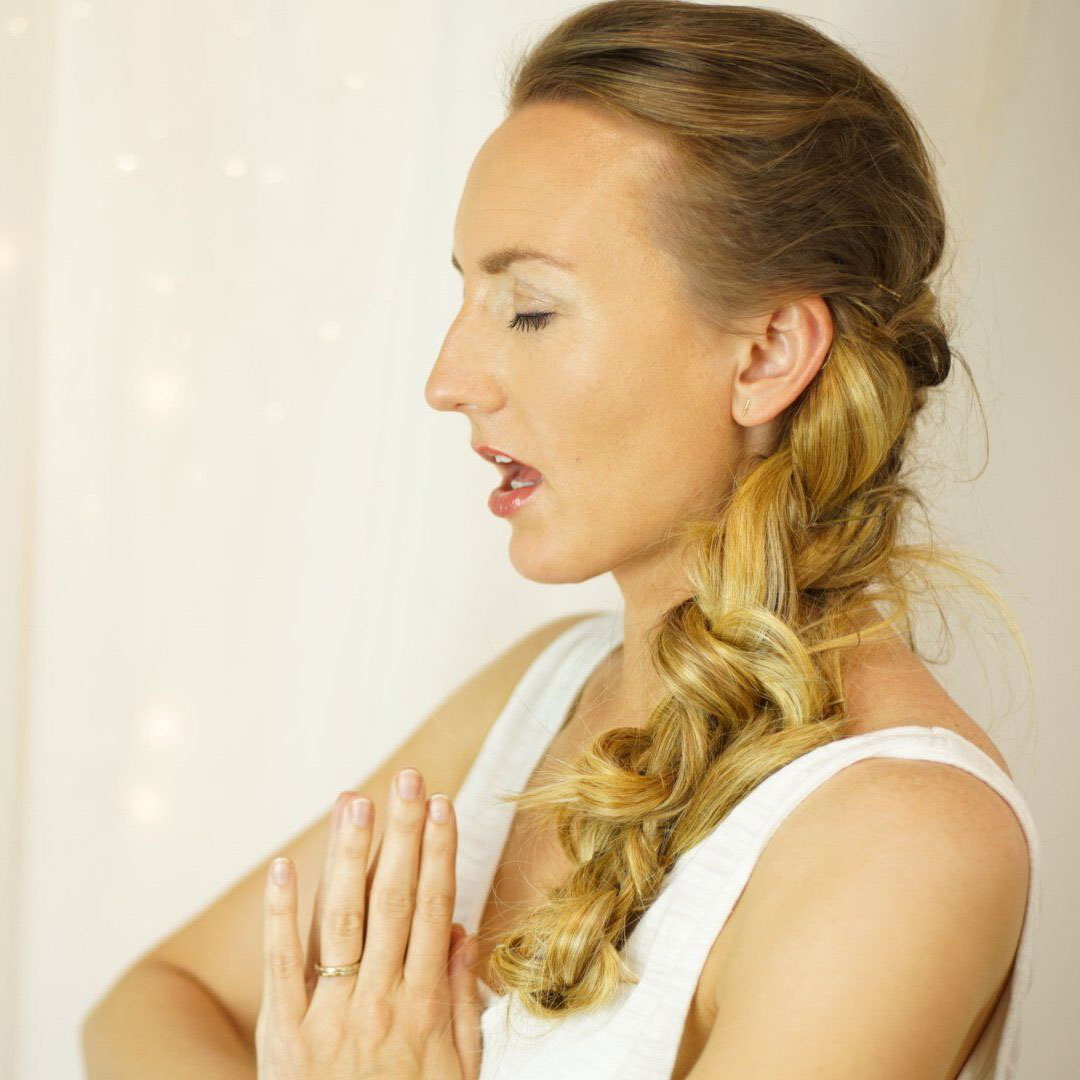
You know those yogic breathing exercises that your yoga instructor always talks about?
Well, there’s a big reason why they’re incorporated into every yoga class.
In fact, they are just as important as the ‘yoga’ that you’re doing.
It’s true.
Pranayama breathing is one of the eight limbs of yoga…
…your asana practice, or the yoga postures that you move through in your yoga class, is another limb of yoga.
And Ujjayi breathing is one of the breathing exercises that falls under pranayama breathing.
Before we dive into my top 3 tips for this type of yogic breath, let’s go over some of the benefits of Ujjayi breathing and how you can work it into your practice.
Benefits of Ujjayi Breathing

Many will tout the benefits of ujjayi breath, claiming that it helps calm the mind, reduce blood pressure, slow the heart rate, and bring fresh oxygen to your muscles and brain.
And it’s all true.
How?
Deep breathing, called diaphragmatic breathing in modern science, resets the vagus nerve. The vagus nerve is one of the major neural pathways that connects the brain to the body and helps regulate things like blood pressure, heart rate, and digestion.
And when you take a deep breath, it stimulates the vagus nerve so that all of those things it regulates are instantly calmed.
It’s a part of the parasympathetic nervous system, which is basically the exact opposite of ‘fight-or-flight’ mode.
In fact, it’s cutely named the ‘rest and digest’ mode because it helps slow all of your bodily functions so that your body can focus on, well, resting and digesting.
With each inhalation and exhalation, you can calm your entire body, from the inner workings of your mind to the actual organs within your body.
The best part?
Yogis knew this all along and made pranayama breathing an essential part of yoga.
Pranayama is the sanskrit word for breath (prana) and suspension of breath (yama).
Or, in other words, inhalation and exhalation.
Basically, slow, deep breathing.
While ujjayi breathing can be used in your asana practice, it doesn’t need to be limited to only the yoga mat.
In fact, you can incorporate yogic breath into your daily life as well.
Whenever you feel yourself getting stressed or frustrated or whatever, simply bring awareness to your breath and begin practicing the breathing patterns I outline in this video. With each deep breath, you’ll find your heart rate slow and your mind quiet down.
Seriously, it’s magic.
Ancient yogic wisdom that is fully supported by western science.
Ready to get started? Watch the video below or read the transcription for my top 3 tips my favorite yogic breathing, ujjayi pranayama.
You might also like: 3 Steps to Alternate Nostril Breathing That Will Cut Stress Fast [VIDEO]

How to do Ujjayi Pranayama
Video Transcription
Hello my friends. I’m Brett Larkin and this is a tutorial on how to do you ujjayi breath, also known as victorious breath.
You’re supposed to be breathing this way throughout all of your practice. Anytime you’re doing yoga, at least in the Vinyasa tradition, that can be very challenging.
But I wanted to break down the breath and give you a couple of different analogies of how to think about it and get into it.
Let’s get started.
Tip #1
Ujjayi breath is all about having a gentle constriction at the back of the throat. So one of the first ways that you can experiment with trying to find it is to inhale through the nose, exhale through the mouth, but hold your hand up to your mouth and constricting the back of the throat, breathe out through the mouth like you wanted to fog up or steam up a mirror.
So inhaling through the nose, okay.
And exhaling through the mouth. Inhale through the nose.
Okay.
Exhale through the mouth and that ha, ha sound, like you’re fogging something up. And then keep that. Just do it with the lips sealed.
Now on the exhale, try it again.
So there’s this gentle constriction at the back of the throat and that’s what really is the definition of ujjayi breathing.
Tip #2
And tip number two that I want to offer is for you to just breathe out in the way that you were kind of frustrated with someone. So say someone didn’t do something you really wanted them to do and you’re kind of like angry at them under your breath. So you breathe in and then when you breathe out, it’s like that kind of angry frustration sensation where you’re clenching the back of the throat a little like, I wish you had done this. Like I asked you to.
Okay, feel that constriction at the back of the throat.
Of course you don’t want to feel angry or frustrated when you’re doing yoga, but I think that analogy can help you find that kind of clenching in the back of the throat that we’re looking for.
Tip #3
My third tip for you is that when you do Ujjayi, you breath thinking of equanimity.
So you want the inhales and exhales to be equal length.
So if you inhale for a count of three, you want to exhale with that constriction at the back of the throat for a count of three as well. If you’re inhaling for a count of five, you want to exhale for a count of five.
So of course if you’re a beginner or you’re new to yoga, I suggest starting with a three count so you can have your inhales and exhales equal length, but as you advance in your practice, you can work all the way up to inhaling for an eight count and exhaling for an eight count.
The most important thing is that you have equity in the inhale and exhale. This is an important part of doing ujjayi breath correctly. It’s important for really getting the most out of your yoga practice.
Since breathing in this way, it stimulates the relaxation response in the body at a neurological level.
Now, I’d really appreciate it if you’d give this video a like and subscribe to my channel if you haven’t already, to officially become part of the community and leave me a comment down below.
Did this answer some of your questions about Ujjayi breath? Are you still struggling with it? I’d love to hear from you if you want to be even more supported.
I’m going to invite you to join our private Facebook group, Yoga Hacks Community on Facebook where you can be surrounded with some of the most amazing Yogis on the web. So much love from my heart to yours. Namaste.
Experience 3 Training Videos from Inside My 200-Hour Online YTT

YOU MIGHT ALSO LIKE
- What is Kriya Yoga? The Philosophy and Practice
- Uddiyana Bandha: Tapping Into Your Deep Core
- 4 Reasons Hasta Bandha Is Essential To Your Yoga Practice
- Vitarka Mudra: What It Is and How Do You Use It?
- Shakti Mudra: What It Is and How Do You Do It?
- Garuda Mudra: What It Is and How Do You Use It?
- Kali Mudra: What It Is and How Do You Do It?
- Shunya Mudra: What It Is and How Do You Do It?
- Varuna Mudra: What It Is and How Do You Use It?
- Vayu Mudra: What It Is and How Do You Use It?
- Samana Vayu: The Energy of Balance & How to Access It
- Apana Vayu: The Energy of Release & Surrender
- Udana Vayu: The Ascending Wind
- Prana Vayu: The Breath of Vitality
- Vyana Vayu: The Energetic Secret to Flow
- Saucha: 6 Ways Purify Your Body, Mind, Relationships & Space
- Aparigraha: 6 Ways To Completely Let Go In Yoga
- Brahmacharya: Yoga’s Guide To Sensual Indulgence
- Tapas In Yoga: 4 Ways This Niyama Will Light Up Your Life
- How To Practice Satya: Ask Yourself These 3 Simple Questions
- What is Mula Bandha and How to Practice It
- The Meaning of Anjali Mudra: Yoga’s Sacred Greeting
- Jalandhara Bandha: 4 Reasons Yogis of All Levels Should Practice It
- Pada Bandha: Your #1 Secret to Happy Feet
- Beyond Corpse Pose: 13 Questions About Restorative Yoga, Answered
- What is Asteya? 5 Powerful Ways to Practice Non-Stealing in Yoga and Life
- Understand the Koshas and Discover 5 Deeper Dimensions of You
- 4 Modern Ways to Deepen Your Svadhyaya (Self Study) Practice
- What are Patanjali’s Yoga Sutras?
- Why Ahimsa (Non-Violence) Improves All Areas of Your Life
- What Is Santosha? Yoga’s Philosophy of Happiness.
- Ishvara Pranidhana: How to Surrender to the Universe
- What Are Nadis? Your Guide to Energy Channels In Your Body.
- The Complete Glossary of Sanskrit Words Used in Yoga
- Where Did Yoga Originate: A Brief History of Yoga








